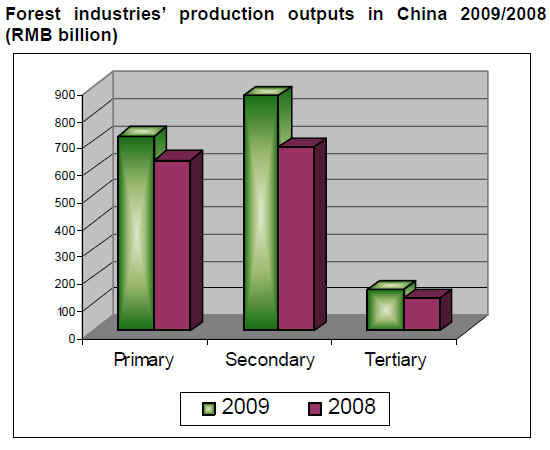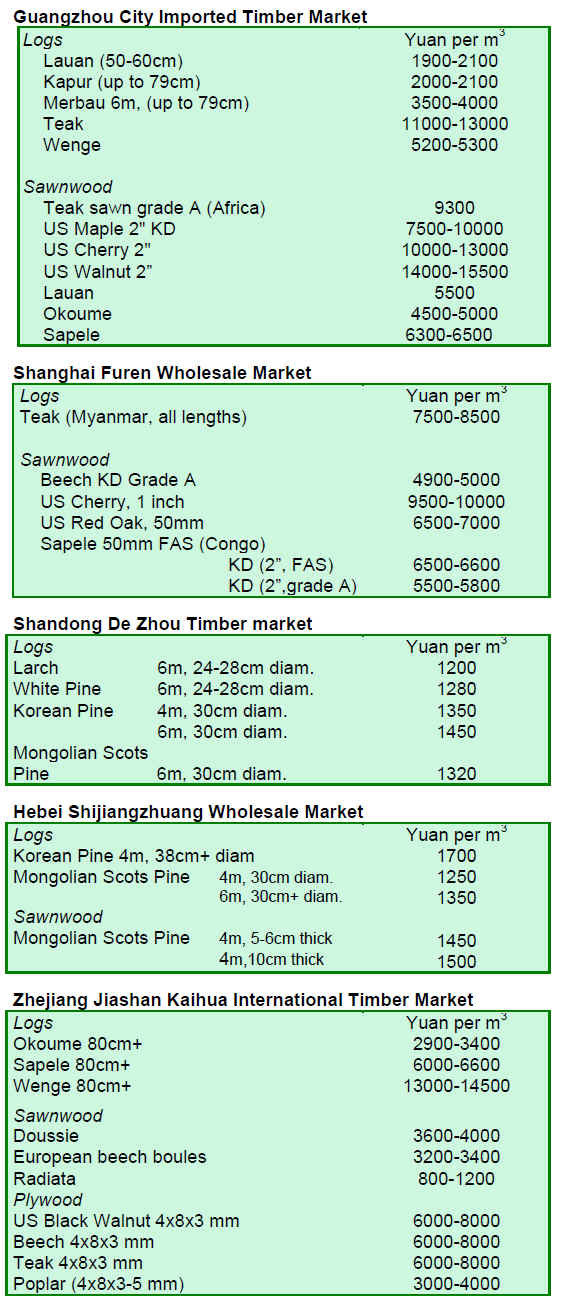US Dollar Exchange Rates of 28th July 2010
China Yuan 6.7782
Report from China
China adjusts export tax rebates
According to the Ministry of Finance and the State
Administration of Taxation, China removed export tax
rebates on 406 items effective from 15 July 2010.
The commodities that will no longer enjoy export tax
rebates include certain steel products, non-ferrous
processed metal products, silver powder, alcohol, corn
starch, crop protection products, medicine, chemicals,
plastic products, rubber and related products. These goods
used to have tax rebate rates ranging from 5% to 17%.
Wood products are still enjoying export tax rebates as
means to promote them as green alternatives.
The export tax rebate removal is aimed at restricting the
export of "high-pollution, high-energy consumption and
resource-dependent" products in order to accomplish
energy and emission reduction targets during the Five-
Year Plan period (2006-2010).
National forest industry statistics 2009
The State Forestry Administration, the State Development
and Reform Commission, the Ministry of Finance, the
Ministry of Commerce and the State Administration of
Taxation have jointly published the Plan for the
Revitalization of the Forest Industry 2010-2012. The
publication introduces and employs the 2009 forest
industry statistics.
According to the statistics, the total value of national
forest industry output was RMB1.75 trillion in 2009, up
21% compared to the year 2008. The average growth rate
of the output has been about 20% every year since 2001.
Of the total output value, a share of 41% representing
RMB723 billion came from the primary forest industry
(mainly non-wood forest products), a 14% increase over
the output in 2008. The secondary forest industry (mainly
SPWPs and bamboo products) accounted for 50% of the
total output value with RMB872 billion, up 28% from
2008. Tertiary forest industry (mainly tourism and
recreation) accounted for 8.9% of the total with RMB155
billion, up 28% from previous year.

In the primary forest industry, the output value of the
plantation and collection industry including fresh and
dried fruits, tea, Chinese medicine products and forest
food was the largest with RMB390 billion, accounting for
54% of the total primary industry output. In 2009, the
output value of bamboo continued to increase reaching a
9.8% share of the total, which translates to RMB70.9
billion in value. However, the output of timber declined
13% from the level recorded in 2008 to 71 million cu.m in
2009. The value of timber output was RMB76.4 billion
accounting for 11% of the national total.
In the secondary forest industry, the proportion of output
value of the timber and bamboo processing industry
including sawnwood and wood-based panels was the
biggest with 45%, representing RMB393 billion in value.
In 2009, the output of logs was 65 million cu.m, down
13% from the previous year, while the output of
sawnwood was 32 million cu.m, up 14% from 2008. The
output of wood-based panels reached 115 million cu.m, a
23% increase from 2008. The wood-based panel
production was mainly concentrated in eight provinces:
Jiangsu, Henan, Shandong, Hebei, Guangxi, Fujian, Anhui
and Guangdong. The total wood-based panel output of
these provinces was 86.9 million cu.m, accounting for
76% of the national total. The output of wood flooring
recorded 378 million square metres, staying at the 2008
level. The province with the largest flooring output was
Zhejiang with around 72 million square metres.
In the tertiary forest industry, the proportion of output
value of forest tourism and recreation services was the
biggest with 62%, representing RMB96.5 billion in value.
The forest industry statistics of 2009 show that the
structure of forest industry has changed from the ratio of
66:30:4 for primary, secondary and tertiary production in
2001, to the ratio of 41:50:9 in 2009. Out of all forest
industries, the wood and bamboo pulp&paper industry,
wood and bamboo furniture industry, and forest tourism
and recreation services are growing fastest, at the annual
rate of 41%, 40% and 40% respectively.
According to the statistics, the output value in 10
provinces in east China accounted for 47% of the national
total, in 6 provinces in central China 21%, in 12 provinces
in west China 2%, and in northeast China 11%. There
were 9 provinces with the total forestry output value
exceeding RMB80 billion in 2009. The top provinces were
Guangdong, Fujian and Zhejiang.
The total allocated forest sector financing for 2009 was
RMB137 billion, 37% more than in 2008. Some RMB135
billion of forestry finance was completed in 2009.
Mixed price trends in 2009
According to the forest industry statistics of 2009, there
was no common trend for log and major wood product
prices in the market. The average prices in 2009 were as
follows: logs RMB564 per cu.m, down 15.4% from last
year; bamboo RMB7 per piece; sawnwood RMB1,017 per
cu.m, down 6.2%; wood chips RMB661 per cu.m, up
3.3%; wood flooring RMB121 per square metre, up 1.7%;
plywood RMB1,774 per cu.m, down 3.3%; hardboard
RMB1,503 per cu.m, up 23.3%; MDF RMB1,439 per
cu.m, up 2.1%; particle board RMB1,151 per cu.m, up
4.8%.
B.C. logs to be shipped year-round into China
The Fujian Entry-Exit Inspection & Quarantine Bureau
has announced that a trade agreement on Canadian BC
Province Logs to China was recently signed between the
Chinese and Canadian governments. In the agreement, the
import period of Canadian logs to China has been
extended from 7 months to a whole year, in order to meet
the growing demand from timber processing companies in
Fujian Province. The arrangement is also favourable for
Fujian companies in terms of more flexible log import
planning and reduced storage costs.
The former trade agreement signed in 2008 prohibited log
imports from Canadian BC Province between May to
September because of the pest risks. During that period,
Fujian timber processing companies were left without
Canadian hemlock, spruce and Douglas fir logs.
More on BC logs:
http://www.vancouversun.com/business/China+opens+doo
r+logs/3253233/story.html
Log imports through Zhangjiagang surge
Log imports through the Zhangjiagang sea port during the
first half of 2010 jumped 21% to a total of 1.8 million
cu.m. Log imports valued US$504 million, a 53% hike
over the same period in 2009. Of the total log imports, 1.7
million cu.m were shipped in bulk and 60,800 cu.m in
containers, up 19% and 82% respectively from the same
period in 2009.
According to analysts, there are two main reasons for the
surge in log imports:
• Malaysian timber traders increased exports to China
due to the low demand in developed countries. The
total import value of Southeast Asian timber rose 7%
from the first half of 2009;
• Domestic demand for tropical timber and wooden
products has increased steadily in line with China’s
economic recovery.

|